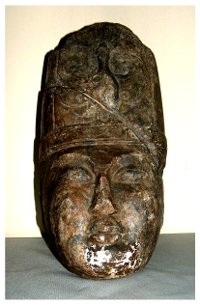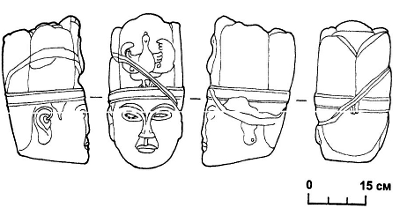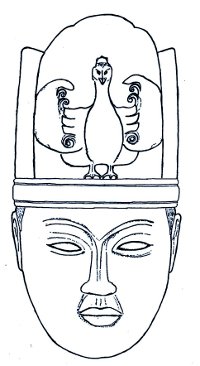The meaning of the word “kul” researchers explain as “well-known, glorified”, “ashes”, “the sea or lake” and so forth. This word in Old Turkic texts is in names “Kultegin, Kultudun, Kulichur, Kulug” and it has one meaning. “Kül+ik//köl +ik means the skilful equestrian, the master, the dexterous equestrian on a horse”. Kultegins horses, his racers are especially described in the inscriptions. It was accepted to connect to the word “Kul” + ethnocultural names as “tegin”, “tudun”, “chur”. So, Kultegin is “the skilful equestrian and a noble man”. A horse is the most honest companion, the friend to the soldier in campaigns. Therefore honouring horses and racers had entered into tradition of nomads.
Kultegin, the wandering commander of Turkic El was born in 685 alongside river Orkhon coast, in Otuken.
 |  |
| the Head of marble sculpture of Kultegin. 732 Mongolia, Orkhon river. “Khocho tsaidam”. (D.Bayar's drawing). |
Second son of Qutlyq (Elteris) kagan, younger brother of Bilge kagan. Mother is Elbilge qatun. Kultegin was the most outstanding leader, the heroic person in history of nomads.
Chinese sources “Kjue-dele//Kjue-tsele”. He was great as kagans as “Modun, Chingiz and Batu”. Even if he was not a kagan, he became the most powerful commander of the Turkic El, he could unite all nomadic ethnos under the blue banner, kept continuity and traditions of nomadic empire, the ingenious hero, the outstanding person. There was anyone who could resist to his sword.
 |  |  |
| Reconstruction of Kultegin’s sculpture (N.Bazylhan, 1998.) | Reconstruction of Kultegin’s stele(N.Bazylhan, 1998ж.) |
When Kultegin was 7 years old, his father Qutlyq (board time 680-692) had died.The throne was inherited by kagan’s brother Kapagan (692-716). Kultegin and his brother Bilge displaced from the throne Bogu, the younger brother of Kapagan, and Bilge kagan took the board (716-734).
Kultegin was a fearless military leader from 16 years, managed to conquer Oguzes, Kidans, Tatabis, Tabgaches (China), Kyrghyzes, Turgeshes, Sogdians, etc.




















































































































